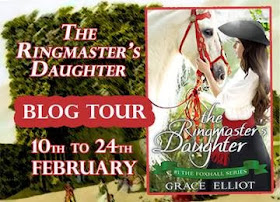The Ringmaster’s Daughter
***
This week I'd like to welcome author Grace Elliott to the blog. She has just launched her latest historical romance, The Ringmaster's Daughter, and I'm delighted to have her here to tell us about the research that underlies her story.
First, a little about the author:
Grace Elliot leads a
double life as a veterinarian by day and author of historical romance
by night. Grace lives near London and is housekeeping staff to five
cats, two teenage sons, one husband and a bearded dragon.
Grace believes that
everyone needs romance in their lives as an antidote to the modern
world. The Ringmaster’s Daughter is Grace’s fifth novel, and the
first in a new series of Georgian romances.
 |
| Grace Elliot |
Curiosity or Research?
Hello,
I’m Grace and I write historical romance but just because I write
‘romance’ does not mean I forsake historical accuracy. History
drives my work and provides the premise behind each book. Take as an
example ‘The Ringmaster’s Daughter’, set in the fictional
Foxhall Gardens, which was inspired by the Georgian and Victorian
visitor attraction, the Vauxhall Pleasure Gardens.
My research takes two forms – reading papers and non-fiction books pertinent to the period and also visiting the places where my novels take place. I need to know the facts, but I’m also a ‘sensory’ writer. I need to be able to imagine the sights, sounds and smells of a place before I can write about it – and this means walking where my characters would have walked.
Research is not a
linear process. A writer doesn’t start off to find out about ‘A’
to the exclusivity of ‘B’ and ‘C’. It was as an offshoot of
research for ‘Verity’s Lie’ that I first visited the Foundling
Museum, London. My intention was to learn about abandoned children in
19th century London, to see the tokens their mothers left,
find out what the children ate and where they slept. As it happened
when I went the museum also had an exhibition about Vauxhall Gardens.
My knowledge of pleasure gardens was hazy but they were very popular
in the 18th and 19th centuries so it seemed
silly to pass up the opportunity and so I paid my £7 and went.
The exhibition opened with an enormous painting showing a panoramic view of Vauxhall Gardens, and a table mounted model of the layout. I saw the tree-lined avenues, the exotic buildings and fanciful lighting schemes and was hooked. My creative juices flowed and I had to know more as it seemed such a wonderful setting for adventure and romance (which indeed, was why the gardens were so popular in their heyday). There were artefacts such as tickets and metal season tickets (polished to a shine by the hands that held them), paintings that once hung on the walls of the supper boxes (and would have been gazed on as patrons ate their slices of cobweb-thin ham), and scores for the music composed by Handel to be played there. I learnt the Foundling Hospital had links to Vauxhall, and famous patrons such as the painter, William Hogarth, and the composer, George Frederic Handel, worked with the gardens on events to raise money for the foundling cause.
This sent me off on a
tangent, on a later date visiting Hogarth’s house in London, to
chase the painter’s connection to Vauxhall and investigate his
lifestyle. Visiting was another wonderful experience since his home
is one of those places where you sense history in the walls, and
thrill that you occupy the same space (albeit hundreds of years
later) where the great man once lived. It transpired the Vauxhall’s
proprietor in the mid 1700’s, Jonathan Tyers, employed master
painters to provide high class pictures for the salons and supper
boxes…
Curiosity or research?
I decided to create my
own fictional version of Vauxhall, and use ‘Foxhall’ as a common
character running through a series of Georgian romances based there.
This doesn’t mean the history is compromised, because I adhere to
strict accuracy, but it gave me designing my own layout gave me
scope for further stories. Indeed, having learnt so much about
Vauxhall, January this year I visited the site of the old pleasure
gardens (and blogged about it: London Then and Now: Vauxhall
Pleasure Gardens http://bit.ly/1fcFFlo
). However, I came away disappointed by the experience.
***
You can buy The Ringmaster's Daughter here:
Amazon US
https://www.amazon.com/dp/B00I2650GS
Amazon UK
https://www.amazon.co.uk/dp/B00I2650GS
And you can learn more about Grace and about her work in these places:
Subscribe to Grace’s
quarterly newsletter here: http://bit.ly/V7T6Jd
Grace’s blog ‘Fall
in Love With History’ http://graceelliot-author.blogspot.com
Grace on Twitter:
@Grace_Elliot
Grace’s author page
on Amazon:
http://www.amazon.com/Grace-Elliot/e/B004DP2NSU/ref=ntt_athr_dp_pel_1
































